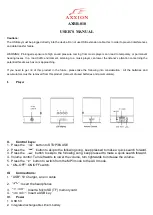
The generator should not be connected to the public power supply. In
case of improper connection there is a risk of fire and damage to prop-
erty, and of electrocution to persons using the generator and working
on the public power supply.
Hazardous voltages are present when the generator is in use. Always
switch the generator off before performing maintenance.
Wear ear protection when using the generator.
Disconnect all equipment from the socket outlets when performing
maintenance or when the equipment is left unattended.
Warning: Gasoline is highly volatile, flammable and explosive.
Warning: Check the oil level before operation.
Choke lever
ON / OFF
Alternating current (AC)
Direct current (DC)
Overload cut-out
General safety instructions
• Please read the complete operating instructions and safety regulations with care.
Any errors made in following the safety regulations and instructions may result in
an electric shock, fire and/or serious injury. Keep all safety regulations and instruc-
tions in a safe place for future use.
• Important: No modifications should be made to the generator.
• Only original parts may be used for maintenance.
• No changes should be made to the settings of the engine or generator. The speed
pre-set by the manufacturer must not be changed, as this may damage the gener-
ator or connected equipment.
• Repairs and adjustment work may only be carried out by authorized trained per-
sonnel.
• Important: Petrol and petrol fumes are highly combustible or explosive.
• Risk of explosion: Never operate the generator in rooms with combustible mate-
rials.
• Do not refuel or empty the tank near open flames, fire or sparks. Do not smoke!
• Important: Exhaust gases can escape despite the exhaust hose. Due to the fire
hazard, never direct the exhaust hose towards flammable materials.
• Always switch off the engine when transporting and refueling the generator.
• Make sure that when you refuel the generator, no fuel is spilled on the engine or
exhaust pipe.
• Place the generator in a secure and level position. Do not turn, tip or change the
generator’s position while it is running.
• Secure the generator against shifting and toppling during transport.
• Secure against electrical hazards.
• Make sure the generator is properly earthed before use.
• Never connect the generator to the mains power supply.
• Never operate the generator in rain or snow.
• Never touch the generator with wet hands.
• Never use faulty or damaged electrical equipment (this also applies to extension
cables and plug connections).
• When working outdoors, use only extension cables approved for outdoor use and
which are marked accordingly.
• The overall length of the extension cables used may not exceed 50 m for 1.5
mm2 and 100 m for 2.5 mm2.
• Important: Risk of burns. Do not touch the exhaust system or drive unit.
• The generator is driven by a combustion engine, which produces heat in the area
of the exhaust (on the opposite side of the sockets) and the exhaust outlet. You
should therefore keep clear of these surfaces because of risk of skin burns.
• Do not touch any mechanically driven or hot parts. Do not remove the safety
guards.
• Children are to be kept away from the generator.
• Important: Danger of poisoning, do not inhale emissions.
• Never operate the generator in non-ventilated rooms. When operating the gener-
ator in rooms with good ventilation, the exhaust gases must be channeled directly
outdoors through an exhaust hose.
• Place the generator at least 1m away from buildings and the equipment con-
nected to it.
• Wear suitable ear protection when near the equipment.
• The values quoted in the technical data for noise level (LWA) and sound pres-
sure level (LWM) are emission values and not necessarily reliable workplace val-
ues. As there is a correlation between emission and emission levels, the values
are not a reliable basis for deciding on any additional precautions, which may be
needed. Factors influencing the actual user emission level include the properties of
the work area, other sound sources, etc., the number of machines and other pro-
cesses in the vicinity, as well as the time span during which the operator is sub-
jected to the noise. Nevertheless, with this information the user is able to make a
better assessment of the dangers and risks involved.
Positions of safety labels
These labels warn you of hidden hazards that may cause serious accidents involv-
ing casualties. Please read carefully the words on the labels, the safety warnings
and the notes in the guide.
Before operation
Check the generator, keep it firmly on a horizontal surface so that it will not topple
over and ensure that the engine is turned off.
Check the oil level
Use only high-quality 4-stroke engine oil. Remove the dipstick, wipe it with a clean
cloth and stick it into the oil filler opening to check the oil level. Do not drop the
dipstick into it. If the oil level is below the bottom of the dipstick, pour the recom-
mended amount of oil into the opening.
Note! The oil level alarm system will turn off the engine before the level descends
to the danger line but, to avoid the inconvenience caused by unexpected machine
shutdown, we advise you to check the oil level regularly.
Labels showing oil level
Engine switch
Display (V/Hz/W)
Warning label
Gas cap
Upper liquid surface
Gas-filling opening
323082_aggregaatti_ko_fi-sv-en-et-lv-lt-ru_A4.indd 16
28.5.2019 9.16.37
Summary of Contents for 323082
Page 45: ...a b on c d e ON OFF 323082_aggregaatti_ko_fi sv en et lv lt ru_A4 indd 45 28 5 2019 9 16 45...
Page 46: ...1 2 2 12 1 2 323082_aggregaatti_ko_fi sv en et lv lt ru_A4 indd 46 28 5 2019 9 16 45...
Page 49: ...Tarmo Tarmo 24 Tarmo 323082_aggregaatti_ko_fi sv en et lv lt ru_A4 indd 49 28 5 2019 9 16 46...
















































